Tomato: Diseases and Symptoms
Tomato: Diseases and Symptoms
Damping Off
Damage symptoms- Damping off of tomato occurs in two stages, i.e. the pre-emergence and the post-emergence phase.
- In the pre-emergence the phase the seedlings are killed just before they reach the soil surface.
- The young radical and the plumule are killed and there is complete rotting of the seedlings.
- The post-emergence phase is characterized by the infection of the young, juvenile tissues of the collar at the ground level.
- The infected tissues become soft and water soaked. The seedlings topple over or collapse.
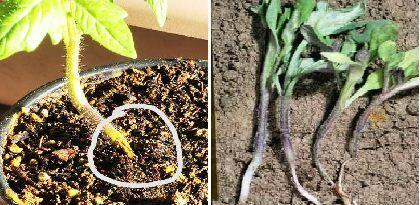
- High humidity, high soil moisture, cloudiness and low temperatures below 24° C for few days are ideal for infection and development of disease.
- Crowded seedlings, dampness due to high rainfall, poor drainage and excess of soil solutes hamper plant growth and increase the pathogenic damping-off.
- Primary: Soil, Seed, Water
- Secondary: Conidia through rain splash or wind.
Septoria leaf spot
Damage symptoms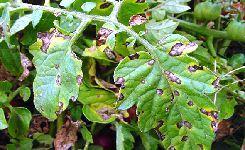 Less vigorous plant are usually affected
Less vigorous plant are usually affected- Small, round to irregular spots with a grey center and dark margin on leaves
- Spots usually start on lower leaves and gradually advance upwards
- Spots coalesce and leaves are blighted
- Complete defoliation of affected leaves
- Stems and flowers are sometimes attacked
- Fruits are rarely attacked
- Primary: Mycelium or conidia in pycnidia in infected plant debris or on solanaceous weeds
- Secondary: Conidia through rain splash or wind and also by slimy conidia sticking on to hands and clothing of tomato pickers
- Poor vigour of plants due to nutrient inadequacy or in late season
- High humidity or persistent dew at 25 °C
- Moist weather with intermittent shower.
Bacterial stem and fruit canker
Damage symptoms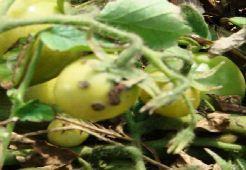 Disease appears as spots on leaves, stems and fruits and as wilting of leaves and shoots
Disease appears as spots on leaves, stems and fruits and as wilting of leaves and shoots- White blister like spots in the margins of leaves
- Spots become brown with age and coalesce, but leaves do not fall off
- Leaflets on one side of rachis show withering initially
- Light coloured streaks on stems and petioles at the joints
- Cracks develop in streaks and form cankers
- Slimy bacterial ooze through the cracks in humid weather
- Small, shallow, water soaked, spots with white halo develop on fruits
- The centers of spots become slightly raised, tan coloured and rough
- Vascular discolouration is seen in split open stems
- Primary: Bacterial cells survive on infected plant debris and seed (both internally and externally) and also on solanaceous weeds such as Solanum nigrum
- Secondary: Bacterial cells transmitted through rain splash
- Soil temperature of around 28 °C
- High humidity or persistent dew
- Moist weather with intermittent showers.
Early blight
Damage symptoms- This is a common disease of tomato occurring on the foliage at any stage of the growth.
- The fungus attacks the foliage causing characteristic leaf spots and blight. Early blight is first observed on the plants as small, black lesions mostly on the older foliage.
- Spots enlarge, and by the time they are one-fourth inch in diameter or larger, concentric rings in a bull's eye pattern can be seen in the center of the diseased area.
- Tissue surrounding the spots may turn yellow. If high temperature and humidity occur at this time, much of the foliage is killed.
- Lesions on the stems are similar to those on leaves, sometimes girdling the plant if they occur near the soil line.
- Transplants showing infection by the late blight fungus often die when set in the field. The fungus also infects the fruit, generally through the calyx or stem attachment.
- Lesions attain considerable size, usually involving nearly the entire fruit; concentric rings are also present on the fruit.

- Primary: The fungus spends the winter in infected plant debris in or on the soil where it can survive at least one and perhaps several years. It can also be seed borne.
- Secondary: The spores are transported by water, wind, insects, other animals including man, and machinery. Once the initial infections have occurred, they become the most important source of new spore production and are responsible for rapid disease spread.
- Warm, rainy and wet weather
Bacterial leaf spot
Damage symptoms- Moist weather and splattering rains are conducive to disease development. Most outbreaks of the disease can be traced back to heavy rainstorms that occur in the area.
- Infected leaves show small, brown, water soaked, circular spots surrounded with yellowish halo.
- On older plants the leaflet infection is mostly on older leaves and may cause serious defoliation.
- The most striking symptoms are on the green fruit. Small, water-soaked spots first appear which later become raised and enlarge until they are one-eighth to one-fourth inch in diameter.
- Centers of these lesions become irregular, light brown and slightly sunken with a rough, scabby surface.
- Ripe fruits are not susceptible to the disease. Surface of the seed becomes contaminated with the bacteria, remaining on the seed surface for some time.
- The organism survives in alternate hosts, on volunteer tomato plants and on infected plant debris.

- Primary: Bacterial cells survive on infected plant debris and seed (both internally and externally) and also on solanaceous weeds such as Solanum nigrum
- Secondary: Bacterial cells transmitted through rain splash
- Moist weather and splattering rains
- High humidity or persistent dew.
Bacterial wilt
Damage symptoms- Characteristic symptoms of bacterial wilt are the rapid and complete wilting of normal grown up plants.
- Lower leaves may drop before wilting. Pathogen is mostly confined to vascular region; in advantage cases, it may invade the cortex and pith and cause yellow brown discolouration of tissues.
- Infected plant parts when cut and immersed in clear water, a white streak of bacterial ooze are seen coming out from cut ends.
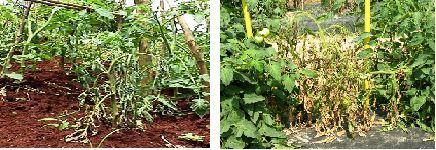
- The spreads through wounds, soil and implements.
- Relatively high soil moisture and to be checked.
Leaf curl
Damage symptoms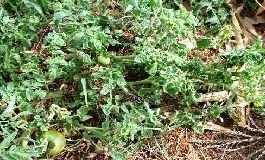 Leaf curl disease is characterized by severe stunting of the plants with downward rolling and crinkling of the leaves. The newly emerging leaves exhibit slight yellow coloration and later they also show curling symptoms.
Leaf curl disease is characterized by severe stunting of the plants with downward rolling and crinkling of the leaves. The newly emerging leaves exhibit slight yellow coloration and later they also show curling symptoms.- Older leaves become leathery and brittle. The nodes and internodes are significantly reduced in size.
- The infected plants look pale and produce more lateral branches giving a bushy appearance. The infected plants remain stunted.
- Whitefly is the vector for transmitting of leaf curl virus.
Mosaic
Damage symptoms- The disease is characterized by light and dark green mottling on the leaves often accompanied by wilting of young leaves in sunny days when plants first become infected.
- The leaflets of affected leaves are usually distorted, puckered and smaller than normal. Sometimes the leaflets become indented resulting in "fern leaf" symptoms.
- The affected plant appears stunted, pale green and spindly.
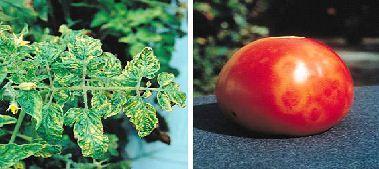
- The virus is spread by contact with clothes, hand of working labour, touching of infected plants with healthy ones, plant debris and implements.
Tomato spotted wilt disease
Damage symptoms- Symptoms vary among hosts and in a single host species
- Stunting is a common symptom of TSWV infection
- Chlorotic or necrotic rings form on the leaves of many infected hosts
- Thickening of veins and bronzing of young leaves
- Growing tips may die-back and terminal branches may be streaked
- Affected plants may have a one sided growth habit or may be entirely stunted and have drooping leaves, suggesting a wilt
- Pale red or yellow areas with concentric circular marking in the normal red skin of ripe tomato are formed
- Discoloration of seed.
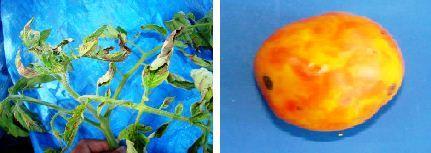
- Primary: Virus particles in infected plants of many hosts like Acanthospermum hispidum, Aster sp., Boerhaavia diffusa, Chrysanthemum sp., Cleome gynandra, cowpea, Dahlia variabilis, egg plant, French bean, Gerbera sp., groundnut, Lagasca mollis, lettuce, marigold, pea, chilli, pineapple, potato, Trianthema portulacastrum, water melon and Zinnia elegans
- Secondary: Virus particles transmitted by thrips, Frankliniella schultzii, Scirtothrips dorsalis.
Fusarium wilt
Damage symptoms- The first symptom of the disease is clearing of the veinlets and chlorosis of the leaves.
- The younger leaves may die in succession and the entire may wilt and die in a course of few days. Soon the petiole and the leaves droop and wilt.
- In young plants, symptom consists of clearing of veinlet and dropping of petioles. In field, yellowing of the lower leaves first and affected leaflets wilt and die.
- The symptoms continue in subsequent leaves. At later stage, browning of vascular system occurs. Plants become stunted and die.

- Soil and implements
- Relatively high soil moisture and soil temperature
IPM for Tomato
To know the IPM practices for Tomato, click here.
Source: NIPHM, and Directorate of Plant Protection, Quarantine & Storage
Last Modified : 11/24/2020
© C–DAC.All content appearing on the vikaspedia portal is through collaborative effort of vikaspedia and its partners.We encourage you to use and share the content in a respectful and fair manner. Please leave all source links intact and adhere to applicable copyright and intellectual property guidelines and laws.
RELATED ITEMS
Fenugreek Diseases
This topic covers information about Fenugreek Dis...
Chilli Diseases
This topic covers information about Chilli Disease...
Fennel: Diseases and Symptoms
This topic covers the Information related to Disea...
Cucurbitaceous Vegetable Diseases
This topic covers information about Cucurbitaceous...
